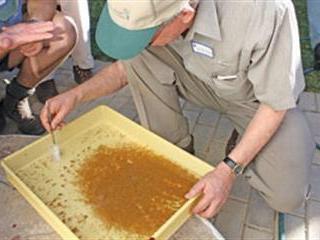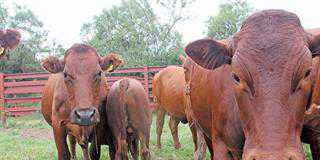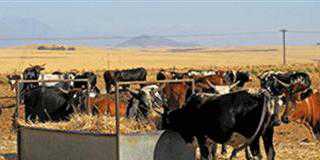
Farmers need to take a leaf out of nature’s book and encourage parasite resilient livestock says Dr Roland Larson, who has been implementing internal and external parasite management in domestic stock for the past 10 years. “Regular treatment as recommended by dosing programmes is out of date,” explains Dr Larson, adding that parasites build resistance to pharmaceutical products.
“We need parasite resistant and resilient animals; genetically fit, productive and adaptable, capable of thriving even with relatively heavy parasite burdens.” The blanket treatment of flocks and herds several times a year, depending on the dosing programme, does not encourage resilience, says Dr Larson. “We need to look at the holistic picture and aim for more target selective treatment (TST).”
He points out that animals doing well despite heavy parasite loads should not be treated irrespective of condition, as they provide a stable resistant core for the herd or flock. For example, desert horses of the Namib maintain reasonable condition although their rate of infestation is high. It indicates their resilience and adaptation to their environment under conditions of natural selection.
“Parasite loads or counts alone are not the issue. We need to look at specific animals and specific conditions and practice TST if and when parasites have an adverse effect,” says Dr Larson. With broad spectrum anthelmintics (dewormers) livestock managers have been trying to eradicate parasites. Stockmen need to understand the ecology and life cycle of various parasites, the conditions in which they flourish and the specific treatment.
“We are heading towards a possible treatment cul-de-sac. Veterinary products are expensive to research and develop and they only constitute two percent of worldwide use of pharmaceutical products,” continues Dr Larson. He cautions that only two products came onto the market last year and there is nothing in the veterinary pharmaceutical pipeline.
The efficacy of current products needs to be maintained for as long as possible. Dr Larson explains that parasites are part of a natural biological control which helps rid systems of the weak and ensures survival of the fittest animals. “A healthy balance of parasites combined with strong resilience in the animal is ideal.”
Small but powerful
Primary internal parasites that affect sheep, goats and cattle are roundworms (wireworm, long-necked bankrupt worm, bankrupt worm, brown stomach worm) tapeworm and the liver and conical flukes. In keeping with more sustainable management programmes, Dr Larson explains that he asks a whole range of questions to help farmers understand more fully the environment in which they are raising livestock, the livestock themselves and the parasites. From here, TST can be applied.
“I ask my clients if they know when to treat, which parasites are on their farms, in which camps and age groups. I find out how often they treat and what follow-ups they do to check drug efficacy. “Indiscriminate drug use in livestock production systems has dire consequences. “Farmers should take care when buying livestock that may have been regularly dosed with anthelmintics by the seller and have little to no resistance to parasites. A quarantine period is advisable.”
Refugia
Parasite populations that have not been exposed to continuous drug use and therefore remain susceptible (i.e. not resistant) to anthelmintics are called refugia. “We want to utilise refugia because a large population of susceptible parasites versus a small population of resistant parasites presents an advantage in any control programme. Common sense dictates that managing stock reinfected with refugial parasites after drenching is easier than that of animals with drug resistant parasite infestation.”
The good the bad and the ugly
“Take dung samples to your vet on a regular basis so that he understands what is happening to specific groups of animals in your flock or herd on your farm,” advises Dr Larson. Samples need to be taken from the same animals each time to be meaningfully assessed. The vet also needs to know whether stock is moved after treatment or whether it stays in the same camp or on the same pasture.
“Parasite ecology differs and some areas, such as irrigated pastures, are more prone to infestation than others.” The practice of moving animals immediately after drenching to avoid reinfestation has changed says Dr Larson. “Now we think they should be moved after two to three weeks to allow for the refugia effect.” He explains that the geographic location of the farm, the environment and the micro- and macro-minerals available can affect parasite loads.
Hipobiosis is a term used to describe the mechanism of inhibited development parasites use to survive inside the bodies of their hosts, especially during unfavourable conditions. Wireworm, for example, weathers the harsh Karoo winter inside its host since it would struggle to survive in temperatures of -10°C. In comparison, the long-necked bankrupt worm is a cold-tolerant parasite that is quite capable of surviving outside its host during winter.
He says that relationships between parasites need to be taken into account. Some worms, such as wireworm and bankrupt worm, do not co-exist. “This means that drenching for a specific parasite may inadvertently be promoting infestation by another.” The most vulnerable groups of animals need attention. So farmers should focus on pregnant animals, lactating animals and young animals (lambs, kids and calves).
A protein-poor diet makes animals susceptible to parasitic infestation, particularly during periods such as late lactation. Micro mineral requirements can play an important role, for example animals lacking selenium will be more prone to worms.
What to do?
“Monitor, monitor, monitor!” emphasises Dr Larson. “The stock is as good as the stockman’s eye.”
Post mortem:
Accurate identification of internal parasites can only be done on post mortem.
Faecal/dung sample analysis:
Submit dung samples to obtain faecal egg counts (FEC). Regularly submitted samples give an indication of the contamination rate in the pasture. The drenching need and product can be recommended and target animals identified after analysis. Targeted Selective Treatment (TST) uses evaluation by FAMACHA, body scoring and the Five Point Check.
FAMACHA is a simple eye test for anaemia caused by wireworm in small stock. The test indicates which animals in your flock need treatment.
The Five Point Check is a body scoring method that examines five signal areas in livestock to determine their overall condition. These include: nasal discharge, anaemic eyelids, bottle jaw, back of the body and coat condition including tail soiling from diarrhoea. The FAMACHA eye anaemia score and the Five Point Check were developed by Professor Gareth Bath and Dr Faffa Malan.
Faecal egg count resistance test:
This is a second faecal egg count within 12-14 days of the first test. The first sample is submitted at drenching; the second sample from the same animals is submitted 12 to 14 days later. The difference between the two samples shows the percentage reduction.
If there were 1 000 eggs/g on the first test and 10 eggs/g on the second, there is a 90% reduction. Unacceptable reduction percentages indicate that the drench is not working effectively, and an alternative needs to be considered. Samples must show the following: the group of animals in the flock or herd selected; the type of pasture or veld; the previous drench and time of administration. They should be kept in an airtight container and can be stored in the fridge for up to seven days before submission.
Management plan
“With an understanding of the farm environment, we can work out a management plan which will lead to host resilience and resistance. This is our ultimate goal and an important component of genetic selection. “A management plan may include using different animals in your camps. Cattle could follow sheep or goats, horses or ostriches could follow cattle. Different species of animals are not susceptible to the same parasites and will act as ‘vacuum cleaners’ to clear the camp before the return of the parasite’s preferred host species.
Where appropriate, camps and pastures may need a two- to three-month rest to break the life cycle of a particular parasite. Once the type and effect of the parasite has been determined, the targeted treatment can be selected. “This approach is labour intensive but in the long run we will be farming far more holistically with animals that are resilient and adaptable, and we will reduce the amount of chemicals being thrown into our environment,” says Dr Larson.
“Farmers who have followed this approach have seen serious benefits and saved money.”
Contact Dr Roland Larson on 049 892 4783 or email at [email protected]













